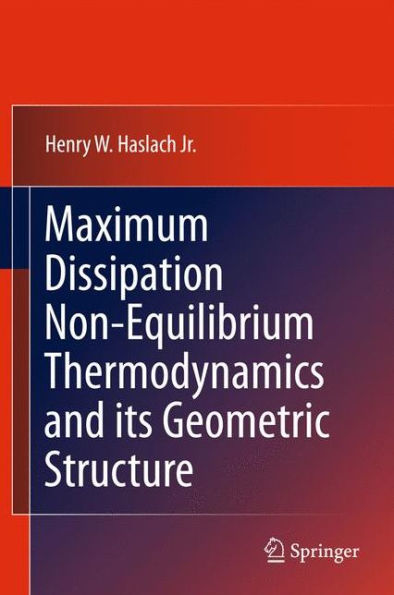Maximum Dissipation Non-Equilibrium Thermodynamics and its Geometric Structure
Maximum Dissipation: Non-Equilibrium Thermodynamics and its Geometric Structure explores the thermodynamics of non-equilibrium processes in materials. The book develops a general technique created in order to construct nonlinear evolution equations describing non-equilibrium processes, while also developing a geometric context for non-equilibrium thermodynamics. Solid materials are the main focus in this volume, but the construction is shown to also apply to fluids. This volume also: • Explains the theory behind thermodynamically-consistent construction of non-linear evolution equations for non-equilibrium processes • Provides a geometric setting for non-equilibrium thermodynamics through several standard models, which are defined as maximum dissipation processes • Emphasizes applications to the time-dependent modeling of soft biological tissue Maximum Dissipation: Non-Equilibrium Thermodynamics and its Geometric Structure will be valuable for researchers, engineers and graduate students in non-equilibrium thermodynamics and the mathematical modeling of material behavior.
1101513288
Maximum Dissipation Non-Equilibrium Thermodynamics and its Geometric Structure
Maximum Dissipation: Non-Equilibrium Thermodynamics and its Geometric Structure explores the thermodynamics of non-equilibrium processes in materials. The book develops a general technique created in order to construct nonlinear evolution equations describing non-equilibrium processes, while also developing a geometric context for non-equilibrium thermodynamics. Solid materials are the main focus in this volume, but the construction is shown to also apply to fluids. This volume also: • Explains the theory behind thermodynamically-consistent construction of non-linear evolution equations for non-equilibrium processes • Provides a geometric setting for non-equilibrium thermodynamics through several standard models, which are defined as maximum dissipation processes • Emphasizes applications to the time-dependent modeling of soft biological tissue Maximum Dissipation: Non-Equilibrium Thermodynamics and its Geometric Structure will be valuable for researchers, engineers and graduate students in non-equilibrium thermodynamics and the mathematical modeling of material behavior.
249.99
In Stock
5
1

Maximum Dissipation Non-Equilibrium Thermodynamics and its Geometric Structure
297
Maximum Dissipation Non-Equilibrium Thermodynamics and its Geometric Structure
297Hardcover(2011)
$249.99
249.99
In Stock

Product Details
| ISBN-13: | 9781441977649 |
|---|---|
| Publisher: | Springer New York |
| Publication date: | 01/25/2011 |
| Edition description: | 2011 |
| Pages: | 297 |
| Product dimensions: | 6.20(w) x 9.30(h) x 1.00(d) |
From the B&N Reads Blog
